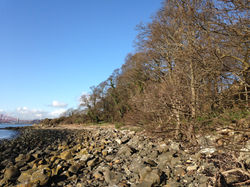Ivy
Joy’s excellent photos of Red Admiral butterflies topping up on nectar from Ivy flowers suggested that Ivy, which is just now coming into flower, would be a good topic for further exploration.
Ivy can present problems, as when it gets into the tops of trees and makes them more vulnerable to winter gales, and when it forms a continuous cover on the ground, excluding all other growth.
However, when growing on a south facing rock outcrop or tree trunk, receiving enough sunshine, it goes into flowering mode and from October to December these bushy growths will have an abundance of spiky yellow flowers.
This is a time of year when most of the flowers have finished for the year and many of the insects that make use of them have also gone into winter mode. But there are some that are still about that make good use of this very useful flower. As captured by Joy’s photos, Red Admiral butterflies, which have emerged after their caterpillars have spent a summer of feeding on our nettles, are a spectacular site on a warm sunny day feeding on Ivy along the Coastal Path.
The Red Admiral is a strong flying migratory species and spreads northward each spring, mainly from southern Europe, before laying eggs to make good use of summer nettle growth. The adults that then emerge in late summer delight us when visiting our late garden flowers. At the end of this period there is then a reverse migration and having sugar rich Ivy flowers to supply energy before the long flight back to Europe must give them a significant and important boost.
But is not just butterflies that make use of the flowers. Less welcome to most are the wasps that also tap this source of nectar, but there are other insects there that, while looking a bit like a wasp, have a very different lifestyle, and certainly do not sting. The larvae of the black and yellow, wasp mimicking, Syrphid hoverfly feed on aphids, so they are welcome visitors to gardens as well, and the flies seen at the moment are the last of several broods over the year.
More abundant at present are the brown Eristalid hoverflies, these look to be Eristalis pertinax the Tapered Drone Fly. They are said to mimic Honeybee drones, hence the name. Their larvae are not aphid eaters but live in organic rich water of drains and polluted pools where they feed on bacteria and decaying material and thus help to clean up organic pollution.
These are just some of the day flying insects visiting Ivy; at night moths will also be visiting. One of the insects disturbed as we collected the strimmed material from our wild flower patch was this small moth, The Chestnut (Conistra vaccinii) a late emerging species that a Fife moth expert, George Guthrie, kindly identified. As well as feeding on the sugars of overripe blackberries, it is also a visitor to Ivy blossoms.
So, while Ivy may be cleared from some areas where it is less welcome in the overall balance of our woodlands, it is important to make sure that we leave some of this important species to flower in the autumn sunshine.







































